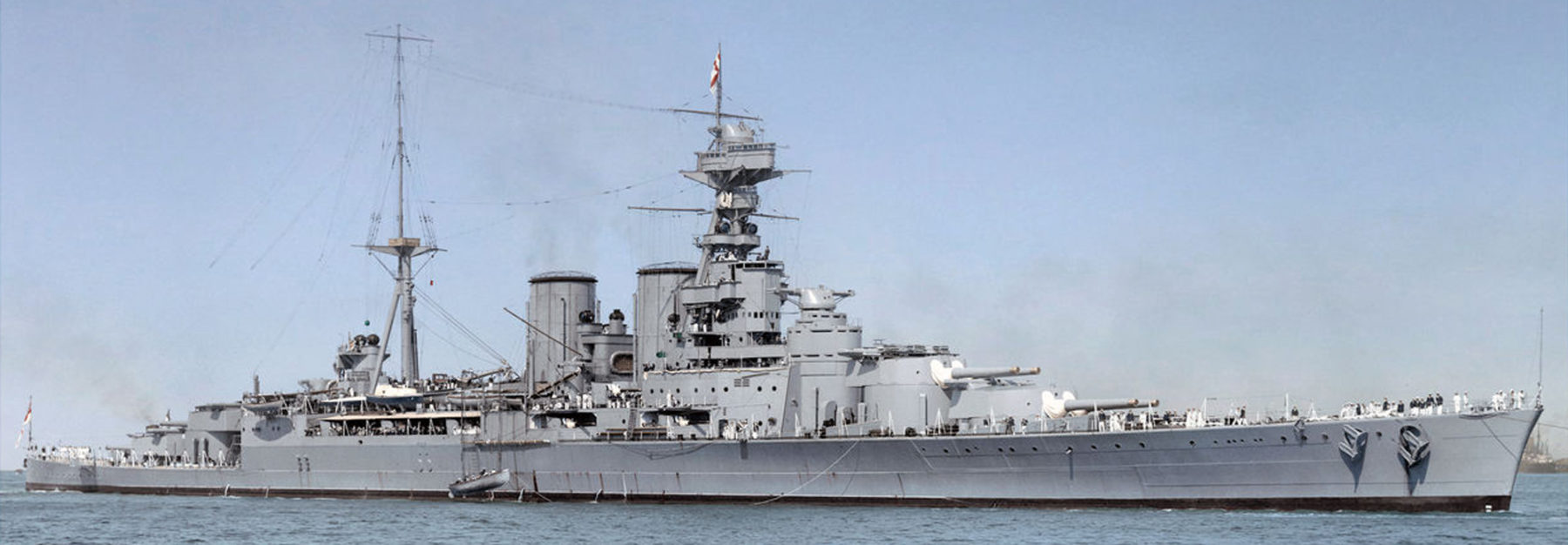The HMS Hood’s Newfound Might
Written on August 20th, 2022 by Ethan Zhang
---------------------------------------------------------------------------------------------------------------------------
Retrofit
The HMS Hood steamed into the Portsmouth Dockyard. Many workers and sailors awaited the Mighty Hood as she was undoubtedly a beautiful ship. The retrofit would grant her everything her crew could ever want. Firepower, speed, and armour as well as the movement of her powder magazine were all in her plans.
It was late 1941. The war was at its peak as the United States joined the allied forces, bringing their industrial might with them. The British admiralty thought it was a perfect time to give HMS Hood her large retrofit that they had been putting off. HMS Hood was brought into the port and the work began.
The first six months were spent merely disassembling HMS Hood’s superstructure and removing her guns, deck, and powder magazines. By the end of February, HMS Hood was a skeleton. Her deck was clean, her interiors empty. Only then did the retrofit begin. The powder magazines that were once the Mighty Hood’s weakness were given an extra layer of steel and placed further below the deck to protect it even further. The deck itself was also given several layers of protective steel as the weight of the ship increased. The HMS Hood’s torpedo belt and side armour were thickened significantly as they loaded the ship with more weight. The engine was changed to a far more efficient engine that gave the ship far more speed and power. Then her armaments came in from the factories.
HMS Hood used to have eight 15” main batteries. Her new main armament was eight brand new 18” rifles in twin turrets that were of a decent fit. Her firepower had been increased drastically as now the ship could fire multi-ton shells several dozen miles. The new armaments were the best weapons in the whole Royal Navy. Her turrets also had new rangefinders that allowed her to fire more accurately. Her main armament was not the only armament that was to change. But first, the superstructure had to be rebuilt.
HMS Hood got a new superstructure that had seven levels. Each level had a deck that was bristling with brand-new anti-aircraft guns. Twenty 5” and thirty .50cal machine guns guarded the HMS Hood. The new bridge was in a block shape and had more room as the smokestacks were given upgrades and cleared room for a floatplane to be launched and recovered using a steam catapult that was designed for battlecruisers like HMS Hood. The new superstructure was massive and the Mighty Hood was undoubtedly the greatest ship of the time. HMS Hood’s radar had also been significantly upgraded with a range that was further than all other ships in the Royal Navy had. HMS Hood was now the premier flagship for the Royal Navy.
---------------------------------------------------------------------------------------------------------------------------
The Mighty Hood
In early April of 1943, HMS Hood sailed out of Portsmouth Drydock. She sailed into the open seas as she was a hunter now. Her first mission was simple. Find and sink the Italian cruiser Pola. This was not a hard mission as the Royal Navy had the cruiser HMS Belfast shadowing Pola and her escort destroyers. The days went by quietly, as Pola and her destroyer escort went into the open seas.
In mid-April, HMS Hood and HMS Belfast made contact with Pola and her destroyer escort. Onboard the HMS Hood, gunners manned their stations as the HMS Hood joined HMS Belfast as they crossed a T in the enemy formation (crossing a T is a naval tactic used to unleash full broadsides while preventing the enemy from doing so). HMS Hood’s gunners fired. Eight 18” shells tore through the air as they raced toward the formation. The destroyers were out of range of their own guns but in range of the Mighty Hood. The shells streaked through the air and scored a direct hit on an Italian destroyer. Two shells hit the destroyer. The ship shuddered from the impact as the rounds tore through the destroyer. The ship’s torpedoes were hit and the ship was ripped violently apart. Nobody survived.
First blood on the first salvo. The Mighty Hood had given Italy a taste of her new power. A second salvo was fired, still out of range of the destroyers. This time, Pola’s game of hide-and-seek was over. Three shells slammed into Pola as she reeled from the hit. Her bridge was decimated by the 18” shells. Then the worst-case scenario befell the Italian fleet. Pola had been critically hit and was leaking fuel. Worse yet, her rudder refused to budge and she was taking on water. The Pola was stuck going in circles. A destroyer was caught in her path. The Pola rammed into the midsection of the destroyer and tore the smaller destroyer apart. The Destroyer creaked as the ship was torn in two as seawater poured into the destroyer. Off in the distance, HMS Hood’s 18” rifles roared. The stricken destroyer was struck again and slipped beneath the waves as another pair of shells struck the Pola’s fuel tank and the Italian heavy cruiser shuddered as the superstructure was hit. The Pola was done for, a sitting duck. Many of her crew abandoned the ship as the fires raged across the deck. The flames found the ammunition locker. The Pola fired one last salvo in defiance as she exploded, killing everyone left onboard.
HMS Hood had single-handedly annihilated the Italian flotilla that had tried to threaten the transport convoys that supplied Britain and Russia. Then she slipped into the shadows. The Italians never knew it was HMS Hood and HMS Belfast. HMS Hood moved towards Britain as the new order came in.
---------------------------------------------------------------------------------------------------------------------------
The Lone Queen of the North and the Pride of the Royal Navy
The HMS Hood received a transmission. Her new command was to set out and rival the KMS Tirpitz, sister-ship to the KMS Bismarck, and known as the Lone Queen of the North. Two of the largest and most powerful battleships on the planet were about to duke it out, just west of Denmark.
The Lone Queen of the North sat in the dock, awaiting her destroyer escorts to come. The battleship was ready to wreak havoc on allied convoys that shipped supplies to Russia to keep their fight alive. KMS Tirpitz’s destroyer escort arrived at the dock. The flotilla steamed out with KMS Tirpitz in the lead. Across the sea, the HMS Hood gathered a small contingent of warships. Heavy cruiser HMS Exeter, which had been retrofitted as well, joined HMS Hood as they sailed out to join the small unit of destroyers that was to join them.
The Royal Navy task force joined up and headed for Norway as the Kriegsmarine forces did the same. The destroyer escorts steamed ahead of their capital ships and scouted the waters ahead. The destroyers clashed as torpedoes hit the waves. A destroyer was hit. Another, then another. Flashes lit up the night as the 5” guns of the destroyers opened up and ripped the others apart. The columns passed and broke off. Several destroyers were sunk on both sides. The remaining destroyers were damaged and were in no condition to fight, let alone fight the enemy capital ships.
The HMS Hood and KMS Tirpitz both got word of the duel and the lack of destroyers for the other fleet. The two capital ships prepared to engage as they drew nearer. Then their radars locked onto one another. They turned, each trying to cross the T, but to no avail. The Mighty Hood and The one Queen of the North formed a row. The battlecruiser fired first and unleashed hell on the enemy battleship as her 18” guns came to bear on the KMS Tirpitz.
The Lone Queen of the North returned fire and then realized she was outnumbered. HMS Exeter opened fire. The heavy cruiser and battlecruiser fired salvo after salvo. The KMS Tirpitz returned every shot. In the afternoon sky, clouds loomed over the KMS Tirpitz. The seas were rough. The rangefinders on both ships were struggling to lock onto the other ship. Then HMS Hood got lucky.
Two 18” shells thundered from one of HMS Hood’s main rifles. The shells hammered the KMS Tirpitz and one struck the side of the superstructure and detonated. Anti-aircraft guns detonated as the ammunition ignited on the ship. The second shell struck the top of the hull. The round penetrated deep into the ship’s stern and tore the ship’s interior apart. One of the boilers on KMS Tirpitz was hit and ceased to function. KMS Tirpitz slowed drastically. HMS Hood and HMS Exeter closed the distance on the slow KMS Tirpitz. KMS Tirpitz fires a heavy salvo at the HMS Exeter and finds the mark as HMS Exeter bursts into flames and immediately creates a smokescreen and retreats, licking her wounds. This left the two capital ships to slug it out as their guns roared.
HMS Hood opened up with her massive 18” guns. A curtain of shells landed all around KMS Tirpitz. The KMS Tirpitz returned fire with her 15” guns. A shell smashed into HMS Hood’s deck. The shell splintered the wood as it hit the steel and punctured a hole as the sound of impact echoed throughout HMS Hood. The Mighty Hood was furious, and another torrent of 18” shells thunder from her guns. The Lone Queen of the North shudders under the fire as many miss by slim margins, many, but not all.
Two shells shatter the bridge and superstructure of KMS Tirpitz. The battleship’s bridge lays in ruin, her radar hanging on by a thread as the side of the ship smokes and dead crew litter the interiors. The HMS Hood doesn’t relent. Another salvo finds its mark. A stricken KMS Tirpitz takes several more hits. Two of her main turrets are hit. The guns explode as they fire their last rounds. The deck lights up as secondary ammunition reserves blaze and send shrapnel across the deck. The last remaining 15” guns on the Lone Queen of the North roar in pain. The shells miss. The Mighty Hood closes the distance as she hammers the enemy battleship with secondary armaments, yet the Kriegsmarine warship refuses to sink.
The Mighty Hood’s guns release a deafening roar as she seals the fate of the KMS Tirpitz. All eight 18” shells rip through the hull of the elite battleship as it begins to take on water. The HMS Hood slips away into the night as the engagement comes to an end. The KMS Tirpitz keels and shudders as the ship lists and begins to slip beneath the waves as fire rages through the deck and the interior of the ship. Then the silence of the night is shattered as a fire triggers the main ammunition depot. The sound echoes through the night. The KMS Tirpitz split in two and the hull sank almost immediately. The stern followed shortly.
---------------------------------------------------------------------------------------------------------------------------
A Sister to the Fallen
The KMS Tirpitz had a brother-ship, the KMS Bismarck. The KMS Bismarck was a foe that could rival the Pride of the Royal Navy. His 15” guns were the same as the KMS Tirpitz, yet his gunners were far more lethal with their accuracy, precision, and training.
The KMS Bismarck set out from the port under the cover of night. In tow was the heavy cruiser KMS Prinz Eugen. Black smoke belched from the smokestacks. They had one mission. Sink the US Atlantic convoys that were shipping war material to Britain and Russia, but the Allies wouldn’t allow that to happen.
KMS Tirpitzand KMS Prinz Eugen slipped into the open ocean with ease. HMS Hood was escorting a convoy that contained vital equipment and material for the Allies. The convoy was well protected. A flotilla of destroyers guarded the perimeter as a battlecruiser and battleship stood on either side of the convoy. HMS Hood and the USS Texas were ready to fight.
Night fell. The KMS Bismarck and KMS Prinz Eugen shadowed the massive convoy. The two massive ships pushed towards the convoy. Dawn broke when the convoy finally made contact with the enemy warships. The HMS Hood and USS Texas broke off the convoy. The admiral knew the danger of U-boats, yet he decided the capital ship and heavy cruiser were a bigger threat than the U-boats that would be detected by the destroyers and promptly sunk.
---------------------------------------------------------------------------------------------------------------------------
Showdown
HMS Hood and USS Texas steamed towards the enemy. They charged towards the front of the formation at an angle that allowed them to bring all of their guns to bear. The two capital ships squared their rifles as the KMS Bismarck locked onto the approaching ships. Then the first salvos were fired from HMS Hood’s 18” guns.
Eight plumes of water erupted just short of KMS Bismarck, the capital ship that was the pride of the Kriegsmarine. USS Texas fired, as KMS Bismarck and KMS Prinz Eugen returned fire. KMS Bismarck volleyed eight 15” shells, andKMS Prinz Eugen fired her eight 8” shells. USS Texas fired her ten 14” shells. None hit their mark. Shells hammered the waves. Dozens of shells were fired from all ships and none found their mark.
Suddenly, the HMS Hood fired a volley of 18” shells, and this time, several shots found their mark. Four shots slammed into the KMS Bismarck’s hull. An ear-splitting explosion rocked the ship. KMS Bismarck began to list to the side.USS Texas fired. The 14” shells slammed into the turrets of the KMS Bismarck. Flames erupted on the deck of the prideful battleship. HMS Hood roared. Her 18” shells ripped apart the KMS Bismarck. The battleship exploded as the magazines erupted and screamed. More shells found their mark. The bridge was hit. The KMS Bismarck found herself crippled and fell silent. Then the pride of the Kriegsmarine slipped beneath the waves, only getting in one last shot at the pair of capital ships. The shot missed by a wide margin. The turrets of HMS Hood and USS Texas steamed towards the KMS Prinz Eugen as she tried to disengage.
The heavy cruiser began to slip away when HMS Hood found her mark. An 18” shell streaked through the air at high velocity. The shell slammed into the rear of the KMS Prinz Eugen. HMS Hood’s 18” barrels smoked as they began to close the distance to the wounded heavy cruiser. Surrounded on both sides and peppered by the high caliber shells fired by the pair of capital ships, KMS Prinz Eugen didn’t last long, suffering the same fate that the KMS Bismarck had met, minutes before.
---------------------------------------------------------------------------------------------------------------------------
Reaching Britain
HMS Hood broke off from the remainder of the convoy, leaving USS Texas as the capital ship in charge. HMS Hood cleared a path to Britain, and the convoy soon made it after. The battlecruiser sauntered into port. Her damage was minimal, astonishing, given she had led the fight against the feared pride of the Kriegsmarine, the KMS Bismarck. The crew of HMS Hood cycled into and out of the towering, yet beautiful battlecruiser. Then after her minor repairs were done, she set out to do it all again. The Pride of the Royal Navy was undeterred. The HMS Hood’s massive 18” guns roared with pride, a lion’s pride.

